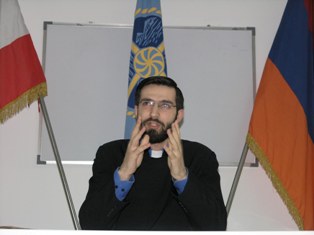
 Lecture on the Armenian Church's musical heritage
Lecture on the Armenian Church's musical heritage
Music is often considered essential for the youth and driven by the interest in Armenian spiritual music, the Armenian Church University Students' Association (ACUSA) organized a lecture dedicated to hymns in its center in Antelias on May 5.
Lecturer Rev. Sdepanos Pashayan first briefly introduced the history of hymns and how they originated, talking about the enrichment of the Armenian Church with new hymns throughout the centuries. Father Pashayan then spoke in more detail about the use of hymns during services and explained the eight musical steps of Armenian Church.
The lecture ended with the teaching of a hymn dedicated to St. Marry, providing the youth with a taste of Armenian spiritual music.
Helping the deprived
The members of the Armenian Church University Students' Association (ACUSA) started regularly visiting and helping deprived families alongside their lectures and social events. ACUSA ventured on this initiative following the advice of His Holiness Aram I.
The initiative includes paying visits to families suffering deprivation as a consequence of the country's economic crisis or for other reasons, encouraging them and helping them with such basic needs as food and clothing.
Caring for the poor is spiritually educational for all people. For the Armenian university students, however, it has been even more valuable in preparing them to face the difficulties and unexpected challenges of life. The project also provides an opportunity to share the pain of others, an exercise, which strengthened the sense of national belongingness of ACUSA members.
Archival wealth
Rev. Fr. Sahag Yemishian, assistant to the director of the Catholicosate of Cilicia's Archives Department, briefly presented the Catholicosate's possession of this wealth in written material to the members of the Armenian Church University Students' Association (ACUSA) on April 28.
Rev. Sahag first highlighted the importance of archives for any government, institution or society. He pointed out that thanks to the unprecedented initiative of His Holiness Aram I, and the Calouste Gulbenkian Foundation, the Catholicosate of Cilicia's archives had all been gathered and stored in one place – a new Archives department.
Rev. Sahag talked about the various types of archival material in the Catholicosate's possession. Thus, the Archives Department's most important section includes the personal works, letters, memoirs, pictures and others of the Catholicosate of Cilicia's last eight consecutive Catholicoi (in Antelias). Particularly important are the material the Catholicosate has inherited from Catholicoi Sahag II and Papken I.
The Archives Department also has reports and meeting minutes by the Catholicosate's various structures, records of written communication between the Catholicosate and its various Dioceses, letters sent by various prominent individuals and officials.
The Catholicosate also possesses archives related to prominent intellectuals such as Puzant Yeghiayan, Shavarsh Nartouni, Nigoghos Sarafian, Simon Mikayelian, Arshag Tchobanian, Teotig and many others. Talking about future plans, Father Sahag mentioned the importance of modernizing the Department with technological facilities.
After the lecture, ACUSA members inspected the Archives Department, getting closely acquainted with the Catholicosate's wealth of written material. They were particularly impressed by the standards of the archives' tidiness and organization that matches the criteria of Western governments.
Photo: Rev. Fr. Sahag Yemishian lectures on “The Archives of the Catholicosate of Cilicia” at the ACUSA center in Antelias, 28 April 2007
